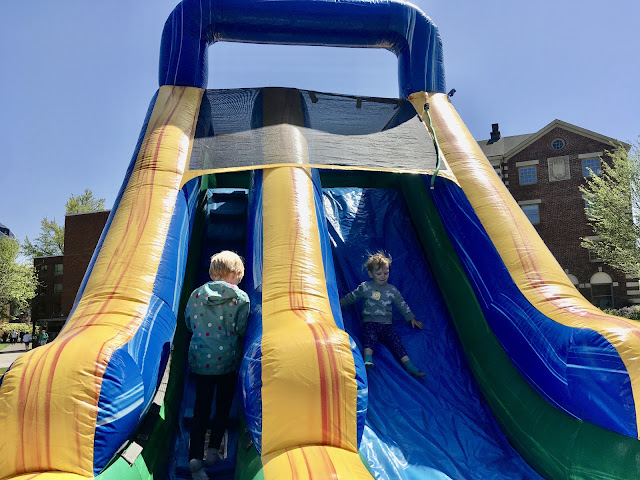Today is Earth Day! The first Earth Day was April 22, 1970, and it still remains a big event in the environmental movement. Interest and participation in Earth Day has increased and spread around the world, with millions of people taking part.

I do many things everyday in my life to help the earth: I live in a small house; I walk and bike, and work at home; I buy used stuff and buy locally; I use the library instead of buying books; I compost, recycle, and grow my own food, I lead an Earthcare support group at my Quaker Meeting, and I work with other climate activists to help change the way we use carbon in our community.
1. Read "Mindfulness-Based Emotional Balance Workbook"
2. Fossil free transitions
3. Sharing Nature
4. Fun Earth Day field trip
1. Read "Mindfulness-Based Emotional Balance Workbook":
I'm reading again from the Mindfulness-Based Emotional Balance Workbook, by Margaret Cullen and Gonzalo Brito Pons (2015). I got it after realizing that mindfulness might be the key to gaining the equanimity I crave. This is supposedly an "8-week program for Improved Emotional Regulation and Resilience"; I'm taking it much slower.
I'm on Chapter 5: Feelings- Pleasant, Unpleasant, and Neutral. "Feeling tones can be described as the flavors that accompany each moment of experience, whether received from the five senses ... or the mind -- sometimes referred to as the sixth sense since it also perceives mental experiences." The goal is to train myself to pay attention to the feeling tone contained in every experience or memory, and therefore observe the experience rather than identifying with it.
Bring awareness to:
- Pleasant Experiences, to reveal the subtle and reliable sources of happiness, which are connection and appreciation of self and others, no expectations or demands, and savoring simple pleasures.
- Unpleasant Experiences, to welcome the unpleasant up front, and view it with compassion and curiosity - looking at it with kindness, and thinking, "Oh, this is unpleasant; I wonder...", which might lead to a creative thought or at least reveal the impermanence of the situation.
- Neutral Experiences, a practice that broadens and adds interest to life: Savoring and reclaiming simple things like walking and breathing, watching the wind, and being kind to the store checker.
2. Fossil free transitions:
Every year for Earth Week I choose a new focus for learning. This year I'm looking at the transition away from fossil fuels, which are the primary source of greenhouse gas emissions, and the biggest cause of climate change.
Transitioning away from fossil fuels involves a global effort to reduce reliance on coal, oil, and gas and move towards renewable energy sources. The transition requires significant investments in renewable energy infrastructure, policy changes, and a global commitment to phase out fossil fuel production and use.
One of the biggest downsides are the environmental, social, and governance (ESG) challenges embedded in this transition. I'm looking at an article called Why Renewable Energy Production is So Challenging, by Advance ESG, an online community that encourages corporations to enact ethical and sustainable policies and practices to safeguard the environment and protect everyone’s rights.
The biggest concern is the resource extraction and processing that our renewable infrastructure demands, which, if poorly managed, can create long-term sustainability risks, many of which will be felt most acutely by vulnerable communities and fragile ecosystems. "The transition to renewables is not a magic bullet. Rather, it’s a complex, ongoing process that requires deliberate planning, ethical sourcing, and adherence to stringent ESG safeguards."
This blog post examines the challenges inherent within renewable energy supply chains, underscoring the urgent need for a transition that’s both swift and sustainable.
3. Sharing Nature:
Yesterday I talked about peace in the garden (quiet, slow, talking to Mother Earth), but today I'll be in the garden with my grandson... so, a very different energy. I found this great post at Kids Gardening on mindfulness for kids, and today I'll try this Observation Exercise (which I have simplified for a two-year-old attention span) that they suggest making into a routine way to enter the garden:
- Stop on the porch and say, "Shhhhh. Quiet garden. Let's look".
- Observe the conditions in the sky, the shape of the clouds, where the sun is in the sky, and what the weather looks like.
- Then make a quiet visit to 3 spots that we can return to throughout the year - I think, the planter on the porch, the raspberries, and the vegetable beds.
- At each spot, ask a question such as: "What sounds do you hear? What do you smell? What color is this flower?"
- At each spot observe in two ways:
- Zoom in and look as closely as you can.
- Look for changes from the last time.



No comments:
Post a Comment